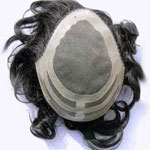Hair System vs Wig
What is the difference between a hair system and a wig or a toupee?
 It is the same as the difference between a garbage collector and a sanitation engineer! Everything is in the packaging!
It is the same as the difference between a garbage collector and a sanitation engineer! Everything is in the packaging!
Shakespeare wrote, “What’s in a name? That which we call a rose by any other name would smell as sweet.†I would change this for the sanitation engineer: “That which we call garbage smells the same under any name you choose to give it. Unfortunately, for many wig wearers, there is a smell that comes with chronic use of wigs unless you have replacement wigs that you wash with some regularity.” It’s not quite as romantic, but it fits.
So to answer your question straightforward — no difference, except for the name. Hair system was coined to market fake hair so that it sound better than wig or toupee.
The picture shows a ‘hair system’ from the bottom (you almost can’t see the hair). What you are looking at in the photo above is the part that attaches to the scalp. To get the best fit, the scalp should be shaved and then the device is glued to the skin with some ‘attachment’ compound. Once glued, it stays in place on the scalp until it is removed and reattached. Many wearers do not do this for themselves, but rather pay someone to do it for them. If the device stays on for a week or more, the sweaty scalp produces an odor which then transfers to the ‘device’. Some people remove it at night and this allows them to shower and wash their scalp. They may also wash their device, but washing it makes it wear out earlier. Alternatives to glue include weaves, which use the existing hair around the head to be weaved through the mesh of the device like thread or clips which can attach the ‘device’ to the existing hair around the edges of the ‘unit’. The clips are better, because they can be easily removed while the weaves can not be moved and must be reworked as the hair grows longer. The average weave becomes more and more loose the longer it stays in place and to make matters worse, it moves as the hair gets longer.
The constant movement of the ‘device’ as the hair gets longer, or the pull from the clips or the glue, creates traction alopecia (hair loss from pulling) which is permanent in almost every person. The sad thing in all of this is that these devices will cause permanent hair loss and dependence upon them. This dependence creates business for the life of the customer.
The reason I think that hair transplants are a better solution is that rather than create dependence, it creates independence. Most of my hair transplant patients say goodbye to me after one or two sessions. From a financial point of view there is no comparison, as the wigs run an average of $3000/year for purchases, replacements, adjustments, repairs and services (and more and more services). Just think of the money a person will spend at $3000/year in 10 years ($30,000) — a far more expensive process than two hair transplants that run between $10,000-$20,000 (hopefully with a stopping point at just two sessions). The existence of a good Master Plan with an honest and reputable hair transplant doctor is critical for the hair transplant candidate who wants to ask “when will it end?”

Reader Comments0
Share this entry
Leave a Comment
Want to join the discussion? Feel free to contribute! Note: We do not tolerate offensive language or personal attacks to other readers. Marketing links or commercial advertisements will be deleted.